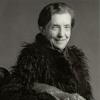Louise Bourgeois

Louise Bourgeois
Louise Joséphine Bourgeois; 25 December 1911 – 31 May 2010) was a French-American artist. Best known for her large-scale sculpture and installation art, Bourgeois was also a prolific painter and printmaker. She explored a variety of themes over the course of her long career including domesticity and the family, sexuality and the body, as well as death and the subconscious. Although Bourgeois exhibited with the Abstract Expressionists and her work has much in common with Surrealism and Feminist art, she was...
NationalityFrench
ProfessionSculptor
Date of Birth25 December 1911
CityParis, France
CountryFrance
Space is something that you have to define. Otherwise, it is like anxiety, which is too vague. A fear is something specific. I like claustrophobic spaces, because at least then you know your limits.
Even though what I do does enter the market, it doesn't interest me. I am exclusively concerned with the formal qualities of my work. It is about the need and the right to self-expression.
My childhood has never lost its mystery, and it has never lost its drama.
I know that when I finish a drawing, my anxiety level decreases. The realistic drawings are a way of pinning down an idea. I don't want to loose it. With the abstract drawings, when I'm feeling loose, I can slip into the unconscious.
I was a 'runaway girl' from France who married an American and moved to New York City. I'm not sure I would have continued as an artist had I remained in Paris because of the family setup.
When my mother died, I fell apart. My father wanted to control me. As a consequence, I ran away to America.
For me, sculpture is the body. My body is my sculpture.
At the dinner table when I was very little, I would hear people bickering... To escape the bickering, I started modelling the soft bread with my fingers. With the dough of the French bread %u2013 sometimes it was still warm %u2013 I would make little figures. And I would line them up on the table and this was really my first sculpture.
The twentieth-century artist who uses symbols is alienated because the system of symbols is a private one. After you have dealt with the symbols you are still private, you are still lonely, because you are not sure anyone will understand it except yourself. The ransom of privacy is that you are alone.
I work like a bee and feel that I accomplish little.
Women had to work like slaves in the art world, but a lot of men got to the top through their charm. And it hurt them. To be young and pretty didn't help a woman in the art world, because the social scene, and the buying scene, was in the hands of women – women who had money. They wanted male artists who would come alone and be their charming guests. Rothko could be very charming. It was a court. And the artist buffoons came to the court to entertain, to charm. Now it has changed, now the younger men are in – older women and younger men.
I was raised a Catholic. But I am not religious. In my work, I am interested in real flesh and blood.
To express your emotions, you have to be very loose and receptive. The unconscious will come to you if you have that gift that artists have. I only know if Im inspired by the results.
Everyone should have the right to marry. To make a commitment to love someone forever is a beautiful thing.